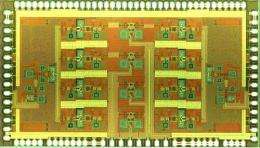Two-Antenna Quad-Beam 11-15 GHz Phased Array RFIC Targeted at Satellite Systems and Advanced Radars

(PhysOrg.com) -- The University of California, San Diego (UCSD) and Jazz Semiconductor, a Tower Group Company, today announced that they have collaborated to develop a two-antenna quad-beam RFIC phased array receiver covering the 11-15 GHz frequency range. First time success was achieved using Jazz Semiconductor’s high performance 0.18-micron SiGe BiCMOS process and its own proprietary models, kit and DIRECT MPW (Multiproject Wafer) program. The chip was designed and tested by the Electrical and Computer Engineering School at UCSD.
“UCSD believes that the quad-beam phased array receiver will enable high-performance phased arrays for satellite communications by integrating many functions on the same silicon chip and replacing several GaAs ICs, drastically lowering the cost of phased array assembly,” said Dr. Gabriel M. Rebeiz, Professor of Electrical Engineering at UC San Diego’s Jacobs School of Engineering, a co-developer of this chip. “Our success in developing this first-of-a-kind chip depended largely on Jazz’s 0.18-micron SiGe BiCMOS process, models and design kit. We view Jazz as a leading specialty foundry with unrivaled design enablement capabilities.”
This is the first demonstration of a single silicon chip capable of producing four simultaneous beams from two different antennas, and together with all the necessary CMOS controlling circuits. Alternatively, this chip can be connected to a single antenna with two different polarization ports, thereby allowing the formation of four simultaneous beams of different polarizations. The four simultaneous phased-array beams can be all at the same frequency, or placed randomly at any frequency in the 11-15 GHz range. Each beam can operate over an instantaneous bandwidth of > 1 GHz with 4-bit amplitude and phase control. As the chip creates four simultaneous beams from the antennas, these beams can point to different areas in the sky (i.e. different angles), preventing the signal gathered in beam 1 to couple to beam 2, and enables at least 30 dB isolation between the two beams.
The SiGe BiCMOS chip operates from a 3.3 V supply, is only 2.4x4.3 mm2, replaces at least 8 GaAs chips, and allows a new generation of high-performance multi-beam phased arrays for X to Ku-Band applications. The SBC18HX process offers high-performance 0.18-micron SiGe bipolar and high quality passive elements combined with high density 0.18-micron CMOS, ideal for high-speed networking and millimeter wave applications. This leading edge process achieves an Ft of 155GHz and an Fmax of 200GHz.
"We are pleased with the results achieved by UCSD with its RFIC quad-beam phased array receiver and are excited to enable an innovative technology designed to address the needs of high data-rate communications and satellite-based systems markets,” said David Howard, Executive Director of New Product Technology at Jazz Semiconductor. “This collaboration demonstrates the capabilities of the highly advanced specialty wafer processes, models and kits we offer to our customers.”
“The chip is currently being transitioned by the U.S. Office of Naval Research to a 1000+ element phased-array capable of four simultaneous beams at Ku-Band, and a contract to a leading U.S. defense company was recently issued based on this chip,” added Dr. Rebeiz.
The chip is available from UC San Diego and interested parties should contact Prof. Gabriel M. Rebeiz at rebeiz at ece.ucsd.edu.
Provided by University of California - San Diego (news : web)


















